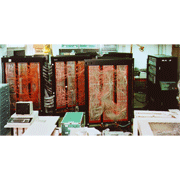Like the QA-1 before it, the QA-2 was prototyped at Kyoto University's Hagihara Lab through the work of many students led primarily by Tomita Shinji and Shibayama Kiyoshi. The QA-1 was a 1970s computer. Both the QA-1 and the QA-2 were designed for high-speed processing needed for computer graphics and used four arithmetic logic units (ALUs) and a very long instruction word (VLIW) architecture. The name QA stood for "quadruple ALUs". Because the term VLIW was not coined by Josh Fisher until 1983, the QA series had previously been known as "low-level parallel processing computers" during their development.
Design work on the QA-2 began in 1978 with microinstructions 256 bits long. The computer was built with 23,000 wire-wrapped ICs. The computer went into operation in the spring of 1983 and was used for three-dimensional computer graphics, real-time animation, and Prolog processing. As it was a prototype computer built in a university lab, the QA-2 was put to work on many student research projects.
Compiled from pp. 190 and 191, "The History of Japanese Computers", edited by the Special Committee for the History of Computing, IPSJ. Ohmsha, 2010.


